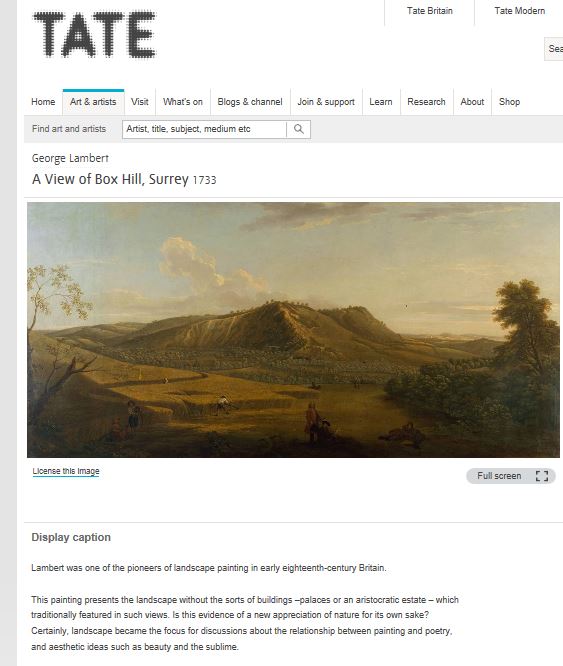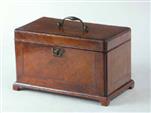">
Antique Toleware Tea Chest of rectangular form with
painted japanned decoration Circa 1765
Please click on images to enlarge | slide show | thumbnail index |
high resolution
|
Description:
Ref: 733TC
http://hygra.com/box/733TC
Rare complex Toleware tea chest
of rectangular form. The outside is decorated with painted
decoration depicting rural scenes on a japanned ocher ground.
Inside the chest there are three
canisters. The two with round caps would have been for tea; the central
canister with hinged lid would have
been for sugar. The chest stands on gilded brass feet.
Origin: UK; Circa:
1765; materials: toleware, tin plated ferrous metal with japanned decoration.
Size: 20.8 cm wide by 11 cm by 13 cm:
8.2 inches wide
by 4.3 inches by 5.1 inches.
Condition: good
overall and does not seem to have suffered the indignation of major restoration;
some of the soldered joins have been re-soldered in the past. This
process has locally damaged the japanned decoration there is some chipping to the paint. (see images)
The chest has its original working lock and key; see images and individual
comments.
Request
current list of available sewing boxes with prices.
Request
current list of available writing boxes with prices.
Request
current list of available jewelry boxes with prices.
Request
current list of available tea caddies with prices.
boxes@hygra.com
|
 (Small).JPG)
Artist painters were employed to paint toleware.
Toleware was the coming together of several developments in art and
technology.
The process of japanning is well described in Treatise of Japanning
and Varnishing John Stalker and George Parker. Oriental lacquered
panels were being imported and fashionable. Chippendale fielded imported
panels in his in some of his furniture.
Tinware sheet seemed to offer an ideal surface for decoration. The invention of a roller rather
than hammering enabled a more even surface to be achieved.
The decoration was baked on.
|

 (Small).JPG)
|
Inside: the Chest has three
lift-out canisters. The two outer with rounded caps would have been for
tea. The central with hinged lid for sugar.
Toleware is tinned sheet
steel or iron. The tin coating was applied to resist rust. The joints
were achieved with solder of the same material a tin lead alloy.
The origin of of the
name is the French tôle peinte. - painted
tin The first tole ware was made early in the 18th
centaury.
Toleware is sometimes known
as Pontypool ware. A factory to produce toleware was established
about 1732 in Pontypool Monmouthshire.
The decoration process, sometimes
called japanning, although brittle, was particularly durable.
The varnish and paint layers were hardened by baking in special
ovens.
When closely inspected a fine
crazing craqueler of the painting is visible
|
Please click on images to enlarge | slide show | thumbnail index |
The sheet steel or iron would
first have been tinned, that is covered in a thin coating of tin. First
the ferrous metal was pickled in acid to remove oxides and impurities.
Tallow was commonly used as a flux. The prepared sheet would then
have been fabricated into the chest.
Tinware canisters were
often fitted to wooden caddies of the time. (see http://www.hygra.com/tc2/tcchsd.htm
).
The construction is clearly visible. The sides are made of pieces
of shaped tin plated iron sheet.
The joins are soldered lap joints.
One of the best and fascinating accounts I have found of
steel working is by Reinhold Rucker Angerstein. (1753-1755) He
seems have been an eighteenth-century industrial spy. He
recorded his findings and detailed observations in illustrated diaries
and notebooks. A translation of the Diary by Torston Berg
and completed his son, Peter was published by the National Museum of
Science & Industry in 2001 ISBN
1 900747243.
There is a preview of the book at: Google
Books.
 (Small).JPG)
|
"Many of the processes were kept secret to hinder competition!
"In connection with Pontypool there is nothing further to be
mentioned except that everything is kept very secret and all
strangers are forbidden to approach the works. Anybody who intends
viewing them must be prepared to use every possible means of
achieving his wish. I did not fail this time, but in the end I
was caught by the implacable proprietor himself and was forced to
witness the castigation of the workmen who let me in. "
"Sheet-metal fabrication in Pontypool
In pontypool there are two brothers by the name of Edward and
Thomas Allgood who from black sheets fabricate bread baskets, tea
trays, snuff boxes and various kinds of of sheet-metal work
that is cut and embossed in rings and then scoured, dried, varnished
and painted in the same way as at Mr Baskerville's factory in
Birmingham. An ordinary snuffbox with a golden flower painted on it
is sold for 2 shillings."
Most surviving tole ware caddies are single and not chests:
See:


|
The chest is hand painted. The scene on the front depicts a
man and woman in typical mid 18th Century clothes with cattle and sheep. It
is an idyllic image of rural life. All is in apparent harmony.
|
 (Small).JPG)
|
Please click on images to enlarge | slide show | thumbnail index |

The paintings on the chest are cutting edge.
The Tate Gallery write of George Lambert's "A
View of Box Hill, Surrey 1733":
"Lambert was one of the pioneers of
landscape painting in early eighteenth-century Britain.
This painting presents the landscape without the
sorts of buildings –palaces or an aristocratic estate – which
traditionally featured in such views. Is this evidence of a new
appreciation of nature for its own sake? Certainly, landscape became the
focus for discussions about the relationship between painting and
poetry, and aesthetic ideas such as beauty and the sublime.
See: www.tate.org.uk/
lambert-a-view-of-box-hill-surrey-n05981 |
 (Small).JPG)
|
Please click on images to enlarge | slide show | thumbnail index |
When closely
inspected a fine crazing craqueler of the painting is visible.
|
 (Small).JPG)
|
Please click on images to enlarge | slide show | thumbnail index |
 (Small).JPG)
|
Detail: In the foreground a
man sits fishing. In the background there is a mill house It is a
typical rural landscape in the new style.
|
Under magnification the cracqueler
|
 (Small).JPG)
|
Please click on images to enlarge | slide show | thumbnail index |
Please click on images to enlarge | slide show | thumbnail index |
The inside of the lid is lined with faded red velvet.
This looks original.
|
 (Small).JPG)
|
 (Small).JPG)
|
The canisters are tinned on the inside. Tinning is a
thin coat of tin and is used to stop the thin iron sheet rusting.
The soldered lap joint is visible. At the edges the
sheet is bent back on itself for strength.
|
Please click on images to enlarge | slide show | thumbnail index |
The chest retains its original lock which is still working. The inside of the chest
is painted red.
|
 (Small).JPG)
|
The canisters are painted. They are decorated with a floral
motif.
This was the beginnings of neo-classicism.
When closely inspected a fine
crazing craqueler of the painting is visible.
|
 (Small).JPG)
|
Please click on images to enlarge | slide show | thumbnail index |
Please click on images to enlarge | slide show | thumbnail index |
 (Small).JPG)
|
The canisters are enameled
with a neo-classical theme of stylized floral garlands.
|
Please click on images to enlarge | slide show | thumbnail index |
Please click on images to enlarge | slide show | thumbnail index |
Please click on images to enlarge | slide show | thumbnail index |
 (Small).JPG)
|
A
|
Please click on images to enlarge | slide show | thumbnail index |
 (Small).JPG)
|
The rounded lid of one of the canisters has been damaged by an
attempt to re-solder. Solder melts at a temperature above that which the
painted decoration can be safely brought!
Luckily whoever attempted this "restoration" recognized the
error before they had caused too much damage.
|
Please click on images to enlarge | slide show | thumbnail index |
Please click on images to enlarge | slide show | thumbnail index |
 (Small).JPG)
|
A
|
Please click on images to enlarge | slide show | thumbnail index |
The underside is painted black.
The feet are attached with solder.
|
 (Small).JPG)
|
Please click on images to enlarge | slide show | thumbnail index |
 (Small).JPG)
|
The join at the
corner has slightly opened. I do not think that the chest would benefit
from restoration as the process of re-soldering would be almost impossible
with out causing further damage to the painted decoration.
All the painted surfaces are
original and without restoration.
|
 (Small).JPG)
|
Same image as above slightly
lighter
The join at the
corner has slightly opened. I do not think that the chest would benefit
from restoration as the process of re-soldering would be almost impossible
with out causing further damage to the painted decoration.
All the painted surfaces are
original and without restoration.
|
Please click on images to enlarge | slide show | thumbnail index |
The handle is made from cast brass. Much of its gilding
survives.
|
 (Small).JPG)
|
Please click on images to enlarge | slide show | thumbnail index |
The claw feet are also cast brass with gilding.
|
 (Small).JPG)
|
 (Small).JPG) .jpg)
|
"Tea Chests": Plate CXXVIII and Plate CXXIX, T
Chippendale The Gentleman and
Cabinet-Maker's Director 1754
engraved by M.Darley Sculp.
The form of the tea chest was published by Chippendale. Generally
the tea Chest contained canisters. These were often made from tole ware.
See:
|
References:
R.R.Angerstein's Illustrated Travel Diary
Japanned Papier Mâché and Tinware
c. 1740-1940 Yvonne Jones
Please click on images to enlarge | slide show | thumbnail index |
All text and images and linked images are ©
1999-2014 Antigone Clarke and Joseph O'Kelly. If you require any further
information on permitted use, or a licence to republish any material, email us
at copyright@hygra.com
| 